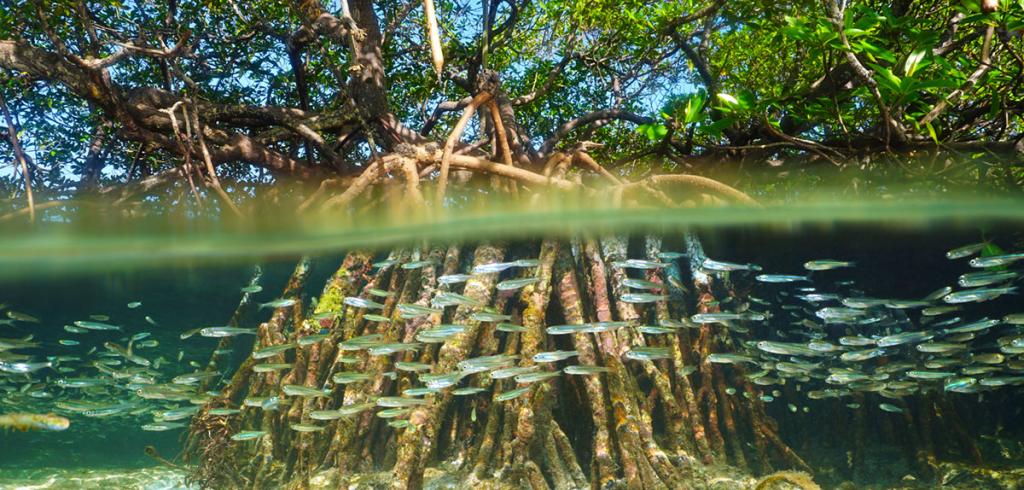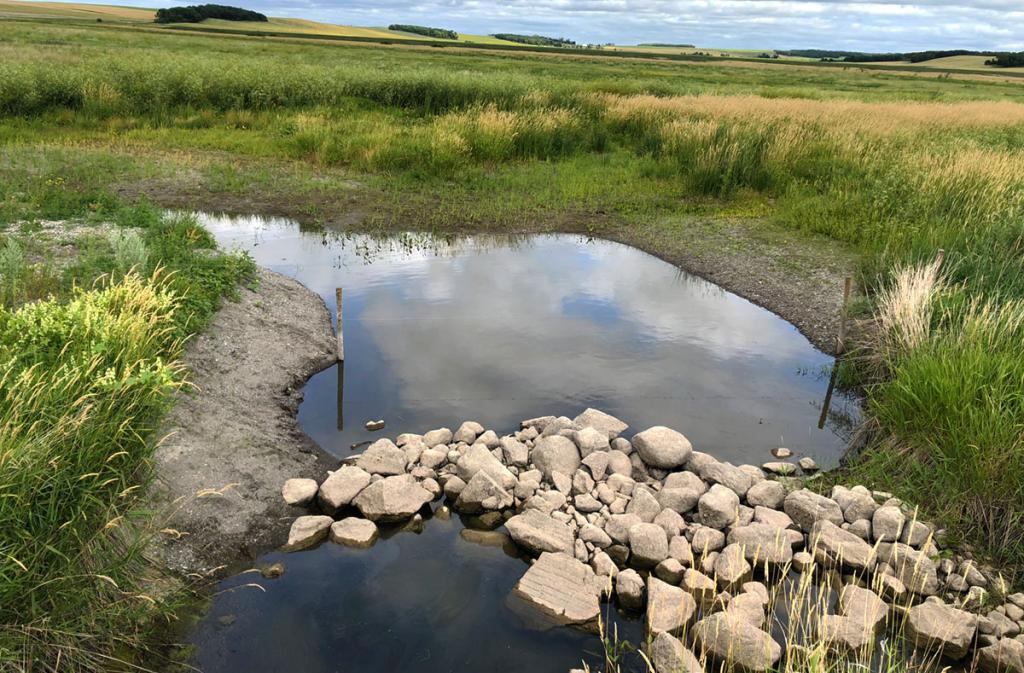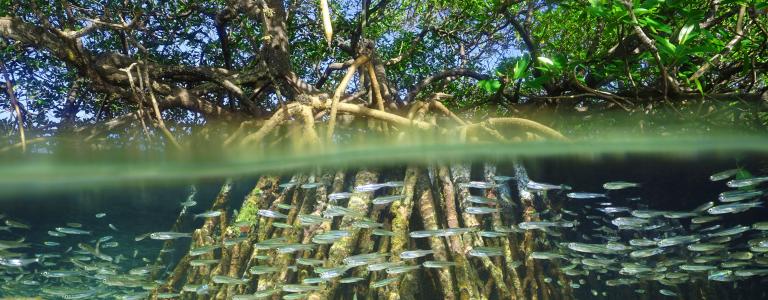Building the Investment Case for Nature-Based Infrastructure
The role of insurance solutions
Climate change and the biodiversity crisis are driving demand for nature-based infrastructure solutions throughout the world. Insurance schemes can help strengthen the financial and physical resilience of these projects.
Why Is the Insurance Industry Important for Nature-Based Infrastructure?
Climate change is increasing the intensity and frequency of both extreme weather conditions and natural disasters around the world. Nature-based infrastructure can help protect communities from hazards such as floods and storms while also providing other valuable ecosystem services. Research shows that the implementation and maintenance of nature-based infrastructure are often more cost efficient than alternative grey (i.e., engineered) infrastructure solutions.
Nature-based infrastructure includes:
- Natural ecosystems that can be conserved, rehabilitated, and maintained in a productive state to deliver a range of ecosystem services and improve resilience against extreme weather.
- Hybrid infrastructure, also referred to as grey-green infrastructure, combines engineered and nature-based solutions. These include constructed wetlands, porous pavements, bioswales for stormwater runoff, sustainable urban drainage systems (SUDS), rain gardens, green roofs, etc.
However, governments often lack the funds to invest in the maintenance of natural infrastructure and to restore it after damages from storms or floods, leading to degradation and decreased protection from future events. After natural catastrophes, government often need to act as “insurers of last resort,” which causes serious pressure on public budgets.
Innovative insurance solutions can help create or strengthen the investment case for the development and restoration of nature-based infrastructure. The insurance industry can play a crucial role in this field for two reasons:
- First, insurance schemes can improve the financial resilience of communities: Insurance policies can protect asset owners and governments from the potentially devastating financial impacts of natural catastrophes.
- Second, insurance schemes can also improve the natural protection of communities against extreme weather events: Insurance companies can offer reduced premiums to customers who invest in risk-reducing nature-based solutions. For example, savings from the reduced premiums for flood insurance could be invested in wetland restoration, which lowers flood risks and creates additional benefits such as new natural habitats and recreation areas.
There are two types of insurance that can be applied to enhance resilience and support nature-based infrastructure: indemnity insurance products and parametric insurance products.
Indemnity insurance compensates the insured party for the loss or damage of a physical asset such as infrastructure or real estate. The insured value is calculated based on the market and reconstruction value of the asset, while the insurance premiums are based on the cost of repairing the asset and the likelihood of damages. Indemnity insurance products are usually used for events with low severity but high frequency, and the payout of claims can involve a lengthy due diligence process.
Parametric insurance products offer coverage to respond to extreme weather events and natural catastrophes. The insurance payments are triggered by a set of parameters or disasters of a specific type and severity predetermined in the contract. For example, in the case of a hurricane, the parameters would be the wind speed and rainfall volume over defined timeframes and in specific locations. Parametric insurances disburse funds immediately after the triggering events, enabling rapid emergency responses as well as longer-term reconstruction.
How Can Insurance Instruments Support Nature-Based Infrastructure?
The insurance industry is becoming increasingly active in the field of resilience and nature-based infrastructure. Here are three examples showing the successful use of insurance instruments in this domain.
Mexican Coral Reefs
Coral reefs reduce wave energy and significantly protect people and properties during storms. In 2019, regional governments in Mexico, The Nature Conservancy, and Swiss Re launched a first-of-its-kind insurance solution for natural infrastructure, aiming to protect the barrier reef in the Mexican state Quintana Roo. The parametric insurance that was created for this purpose covers coral reefs and beaches along a coastline of 160 km of the Yucatán peninsula.

The insurance is triggered if wind speeds exceeding 100 knots are recorded, allowing for rapid disbursement of funds after severe storms. This enables trained community members to quickly begin restoration actions and minimize coral damage, protecting livelihoods and tourism assets related to the reef. The insurance payouts are multi-tiered according to wind speeds, with the maximum payout to be disbursed after events with wind speeds exceeding 160 knots. These calculations are based on wind speed data from previous storms, and payouts are automatically triggered after the predefined storm events, even if no damages occurred.
The insurance of the coral reef is managed through a trust fund: The trust fund purchases the insurance, receives insurance payouts in the case of a severe storm, and is responsible for organizing the reef repair work after such events. The fund also invests in the resilience and maintenance of the coral reef. The communities and asset owners on the coast benefit from the longer-term protection of the reef as a tourism asset, as well as from the insurance payouts that allow for the rapid restoration of the reef and the beaches after storms. The trust fund receives funds from public, private, and philanthropic sources as well as a federal fee collected from beachfront property owners who use the beach for commercial purposes.
Mangrove Restoration and Protection
Mangroves are highly valuable nature-based infrastructure for climate adaptation and mitigation; around the world, mangroves protect more than 18 million people and reduce the flood damage to coastal assets by more than USD 82 billion a year. In addition, mangroves help mitigate climate change by storing large amounts of carbon.
The Global Innovation Lab for Climate Finance developed an innovative instrument that recognizes revenue streams derived from mangrove conservation and restoration. The Lab developed a social enterprise model, the Restoration Insurance Service Company (RISCO), which integrates mangroves’ risk reduction value into insurance products and monetizes the climate mitigation potential of mangroves through blue carbon credits.
In the Philippines, Conservation International is currently implementing the RISCO pilot phase for the Lab, aiming to conserve 3,400 hectares of mangrove forests and restoring an additional 600 hectares. Over 10 years, the pilot is expected to reduce flood risks for 7,000 people, provide a climate benefit of more than 600,000 tons of avoided and sequestered CO2 emissions, and generate more than USD 10 million in revenue from the insurance sector and blue carbon credits.

The RISCO model works as follows: RISCO identifies suitable sites for mangrove conservation and restoration, coordinates with local partners and the insurance industry, and helps the insurance sector evaluate the risk reduction benefits of the mangroves. The insurance companies pay a fee to RISCO for helping with the valuation of mangrove benefits, and for continued, verified mangrove conservation or restoration. RISCO receives funds not only from the insurance sector, but also from investors and blue carbon credit buyers. These revenues are invested in restoring and protecting mangroves, which improves coastal protection and stores significant amounts of carbon. Benefiting from reduced flood risks through the mangroves, the insurance sector offers insurance with reduced premiums to coastal asset owners.
Wetland Restoration on Agricultural Land
The Canadian city of Windsor is facing high flood risks and flood damage per capita. Nearly all wetlands upstream of the city have been drained for agricultural purposes, causing high water runoff in spring and during heavy rainfall. The Insurance Bureau of Canada (IBC) therefore proposes an insurance framework to encourage the proactive restoration and conservation of upstream wetlands. Such wetlands on private agricultural land would protect public infrastructure in the municipality of Windsor from spring flooding, while landowners would be compensated for the land-use change through the insurance.

The IBC proposes that cities like Windsor take out a parametric or indemnity insurance contract for its public infrastructure and receive payouts in case of floods. Meanwhile, a trust fund would manage and fund flood-resilience activities across different jurisdictions, such as hydrology studies and the restoration and maintenance of the upstream wetlands. Upon policy renewal every few years, the new insurance premiums would take into account the flood risk reductions from the wetland restoration projects. The savings from the reduced insurance premiums (along with contributions from other public and private parties like the national government) would recapitalize the trust fund and allow for further wetland restoration and conservation.
The insurance scheme proposed by the IBC is similar to a resilience bond. A resilience bond links insurance premiums to the implementation of projects that increase resilience and reduce risks: Avoided damages in the future are monetized through a rebate on the insurance premiums. The insurance scheme functions similar to progressive life insurance, where reduced premiums are offered if measures are taken to reduce mortality risks. In the case of resilience bonds, the rebate on the insurance premiums forms a source of funding for risk-reducing resilience projects such as wetland restoration.
Conclusion
Opportunity
As shown throughout these examples, the insurance industry can provide solutions that increase both the financial and the physical resilience of communities around the world by supporting nature-based infrastructure. Such innovative schemes are urgently needed to respond to the climate and biodiversity crisis and improve resilience toward catastrophic events.
Scaling up the use of insurance products for nature-based infrastructure offers a wide range of benefits to different stakeholders including local communities, governments of different levels, institutional investors, and the insurance industry itself. These parties could vastly benefit from increased financial and physical resilience through insurance schemes for nature-based infrastructure. Likewise, parties could realize varying benefits ranging from reduced insurance premiums, job creation, and new investment opportunities to the diverse environmental, social, and economic co-benefits of nature-based infrastructure. A crucial step is to identify, measure, and quantify these benefits or avoided costs. IISD is working with the Sustainable Asset Valuation (SAVi) methodology to provide these assessments for nature-based infrastructure, such as for example in the Saloum Delta in Senegal.
However, measuring and monetizing the benefits of nature-based infrastructure over time and harnessing approaches to capture such added value can be challenging, which hampers the broader application of innovative insurance solutions for nature-based infrastructure. The lack of a track record on the performance of nature-based infrastructure, in comparison with the track record of grey infrastructure, is one challenge for the insurance industry as well as for governments and investors. The projects above are nascent examples of building the track record for the investment case for nature-based solutions. To extend the use of insurance solutions for various nature-based infrastructure types, there is a need to create reliable modelling approaches that are not solely based on historical data but also estimate future benefits of nature-based infrastructure projects. With better (and spatially explicit) data, advances in climate projections, as well as site-specific and customized models, it will be possible to also develop and apply insurance solutions to the whole promising spectrum of nature-based infrastructure.
Solution
IISD has long recognized the challenges of quantifying and valuing the benefits of sustainable infrastructure. In cooperation with various partners, it has developed the SAVi methodology to help policy-makers and investors make informed decisions on sustainable infrastructure financing. SAVi allows the evaluation of the financial attractiveness of an infrastructure project across its life cycle, taking into account important environmental, social, economic, and governance factors that are overlooked in a traditional valuation.
IISD is using the SAVi methodology to assess the value of nature-based infrastructure around the world. For example, a recent project analyzed the economic value of the Saloum Delta in Senegal under different development scenarios. The assessment demonstrates (among other things) the positive impact of mangrove restoration on carbon sequestration and water filtering. The assessment of two wetlands in Sardinia, Italy, includes site-specific evaluation of the ecosystem services, the generated labour income, and a comparison with built infrastructure. A new collaboration between the Global Environment Facility (GEF), UNIDO, the MAVA Foundation and IISD will kick off in 2021 to further improve the track record of nature-based infrastructure as an alternative to grey infrastructure for climate adaptation and other infrastructure services.
These projects show that, even though challenging, it is possible to model the multi-faceted value of diverse nature-based infrastructure under different climate and policy scenarios. Stronger collaboration between stakeholders and the insurance sector could therefore be highly valuable for accelerating the use of innovative insurance products for nature-based infrastructure.
You might also be interested in
Sustainable Asset Valuation (SAVi) of Senegal’s Saloum Delta
The assessment provides an economic valuation of the contribution of the Saloum Delta to local livelihoods and regional development.
An Application of the Sustainable Asset Valuation (SAVi) Methodology: Assessing the economic value of restoring the wetlands of S'Ena Arrubia and Corru S'Ittiri-Marceddì-San Giovanni in the Gulf of Oristano in Sardinia, Italy
This assessment uses the Sustainable Asset Valuation (SAVi) tool to calculate the economic and societal value generated by the S’Ena Arrubia and Corru S’Ittiri-Marceddì-San Giovanni wetlands in the Gulf of Oristano in Sardinia, Italy.
How Can We Work With Nature to Tackle Drought and Desertification?
Drought is one of the most devastating and pervasive challenges exacerbated by climate change. However, we can work to reduce its effects through nature-based solutions for land restoration and climate-smart agriculture.
A Balancing Act
With Nigeria's growing population in need of wide-ranging solutions to the multidimensional poverty it faces, a new IISD report outlines how the LNG dash could ultimately leave the economy more vulnerable to external shocks and without a solid domestic foundation.
